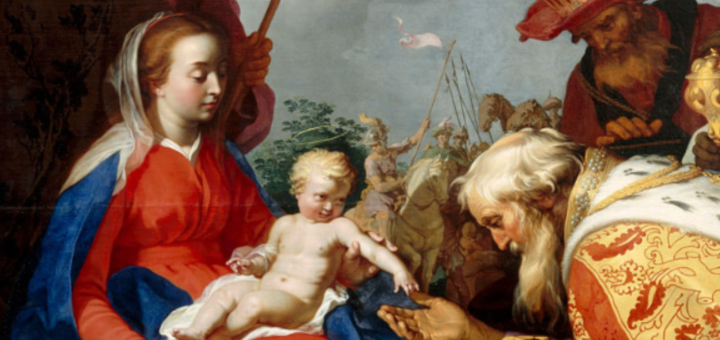
 Fra Angelico, Adoration of the Magi, Wikimedia Commons, Public domain[/caption]
On January 6, I went to my parish church to receive the Sacrament of the Sick and to go to Mass for the celebration of the Epiphany. I was having surgery the next day, which is why this article will be rather short because it is painful to type. While at Mass I heard the Gospel of Matthew recounting the story of the Magi coming to pay homage to the newborn King Jesus.
What I noted was that the wise men were very wise indeed, as they did not pay homage to King Herod, but slipped away to avoid him. They did not even pay homage to Herod in the first meeting; instead, they sought only Jesus. When they finally found Jesus, they prostrated themselves before Him bearing gifts. I wanted to delve into the meaning behind the gestures of prostrating oneself and paying homage.
Fra Angelico, Adoration of the Magi, Wikimedia Commons, Public domain[/caption]
On January 6, I went to my parish church to receive the Sacrament of the Sick and to go to Mass for the celebration of the Epiphany. I was having surgery the next day, which is why this article will be rather short because it is painful to type. While at Mass I heard the Gospel of Matthew recounting the story of the Magi coming to pay homage to the newborn King Jesus.
What I noted was that the wise men were very wise indeed, as they did not pay homage to King Herod, but slipped away to avoid him. They did not even pay homage to Herod in the first meeting; instead, they sought only Jesus. When they finally found Jesus, they prostrated themselves before Him bearing gifts. I wanted to delve into the meaning behind the gestures of prostrating oneself and paying homage.
 Abraham Bloemaert, "The Adoration of the Magi," Wikimedia Commons, Public domain[/caption]
Abraham Bloemaert, "The Adoration of the Magi," Wikimedia Commons, Public domain[/caption]
"They were overjoyed at seeing the star, and on entering the house they saw the child with Mary his mother. They prostrated themselves and did him homage. Then they opened their treasures and offered him gifts of gold, frankincense, and myrrh. And having been warned in a dream not to return to Herod, they departed for their country by another way." (Matthew 2:10-11)In our modern society we never use the word homage. This probably in large part due to the fact that very few people are pledging allegiance to a cause which requires humility. The meaning of the word homage is to submit oneself to the other person and their cause. Submission, is to be part of (sub) the other's mission. Christ's mission is to save the world. This act of the Magi was a public act of allegiance to the baby King to further the purpose and cause of Jesus. To further seal the contract they included their gifts of gold, frankincense, and myrrh. In the paintings and depictions of the wise men seeing Jesus for the first time, they are usually down on one knee, or they are bending to bow to him. They are in the process of making an offering to him. In many cases, they are also lying prostrate.
 Benvenuto di Giovanni, "Adoration of the Magi," Wikimedia Commons, Public domain[/caption]
The act of prostrating oneself is to lay on the ground face down in an act of reverence or submission. Prostration represents overwhelming humility. It can also symbolize death to oneself. This is what priests and monks do when taking the sacrament of Ordination. In many paintings of the Magi coming to worship Jesus, you will see one king at the feet of Jesus, or all of them lying on the ground. You may see pictures of the kings with arms folded over their chests in an posture of unworthiness, or arms held up in prayer in awe and worship.
Today in Mass, or before the Blessed Sacrament, and any other time we raise up our praise we are worshiping, which is similar to paying homage. We can focus on what it means to submit one's whole self to the allegiance of Christ and submit that our new purpose is His purpose and His cause. What is his cause? To save souls, and to serve one another. He came to show us how to serve. We are the shepherds and the sheep. We are to follow, and to lead. We are to follow Christ, and to lead others to follow Christ. This is your mission, "should you decide to accept it*" (by Baptism and Confirmation). *Movie:Mission Impossible
Benvenuto di Giovanni, "Adoration of the Magi," Wikimedia Commons, Public domain[/caption]
The act of prostrating oneself is to lay on the ground face down in an act of reverence or submission. Prostration represents overwhelming humility. It can also symbolize death to oneself. This is what priests and monks do when taking the sacrament of Ordination. In many paintings of the Magi coming to worship Jesus, you will see one king at the feet of Jesus, or all of them lying on the ground. You may see pictures of the kings with arms folded over their chests in an posture of unworthiness, or arms held up in prayer in awe and worship.
Today in Mass, or before the Blessed Sacrament, and any other time we raise up our praise we are worshiping, which is similar to paying homage. We can focus on what it means to submit one's whole self to the allegiance of Christ and submit that our new purpose is His purpose and His cause. What is his cause? To save souls, and to serve one another. He came to show us how to serve. We are the shepherds and the sheep. We are to follow, and to lead. We are to follow Christ, and to lead others to follow Christ. This is your mission, "should you decide to accept it*" (by Baptism and Confirmation). *Movie:Mission Impossible
 Copyright 2019 Marya Hayes. All rights reserved.[/caption]
Copyright 2019 Marya Hayes. All rights reserved.[/caption]
Copyright 2019 Marya Hayes
About the Author

Marya Hayes
Marya Hayes is mother to 3 active teens and is a military spouse. Her days consist of running the household and her mini business, and driving her teens daily all over the planet. Her favorite saints include St Francis de Sales, Saint Benedict, Padre Pio, and JPII. Marya enjoys cooking, hiking, and spending time with the family outdoors. Pray, hope, and don’t worry!


.png?width=1806&height=731&name=CatholicMom_hcfm_logo1_pos_871c_2728c%20(002).png)
Comments